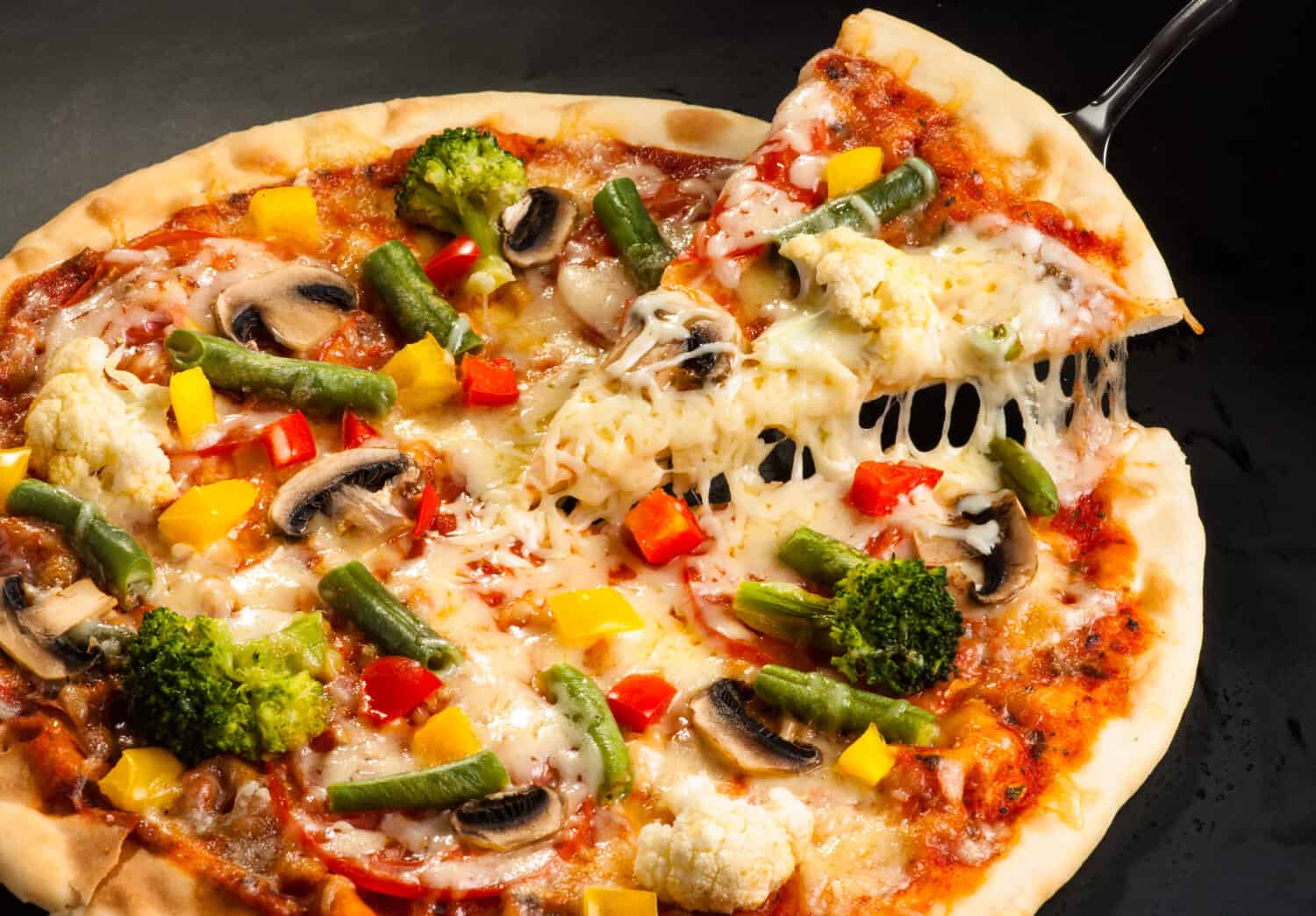Pizza is a popular food enjoyed by many around the world. However, it is commonly labeled as unhealthy due to its high calorie, sodium, and carbohydrate content. The nutrition and ingredients of pizza can vary widely depending on the type, and some varieties can be loaded with unhealthy ingredients. That being said, it is possible to enjoy pizza without gaining weight. In this article, we will discuss whether pizza is truly unhealthy. Plus, we will unveil 8 tips to enjoy pizza without gaining weight!
Is Pizza Unhealthy?
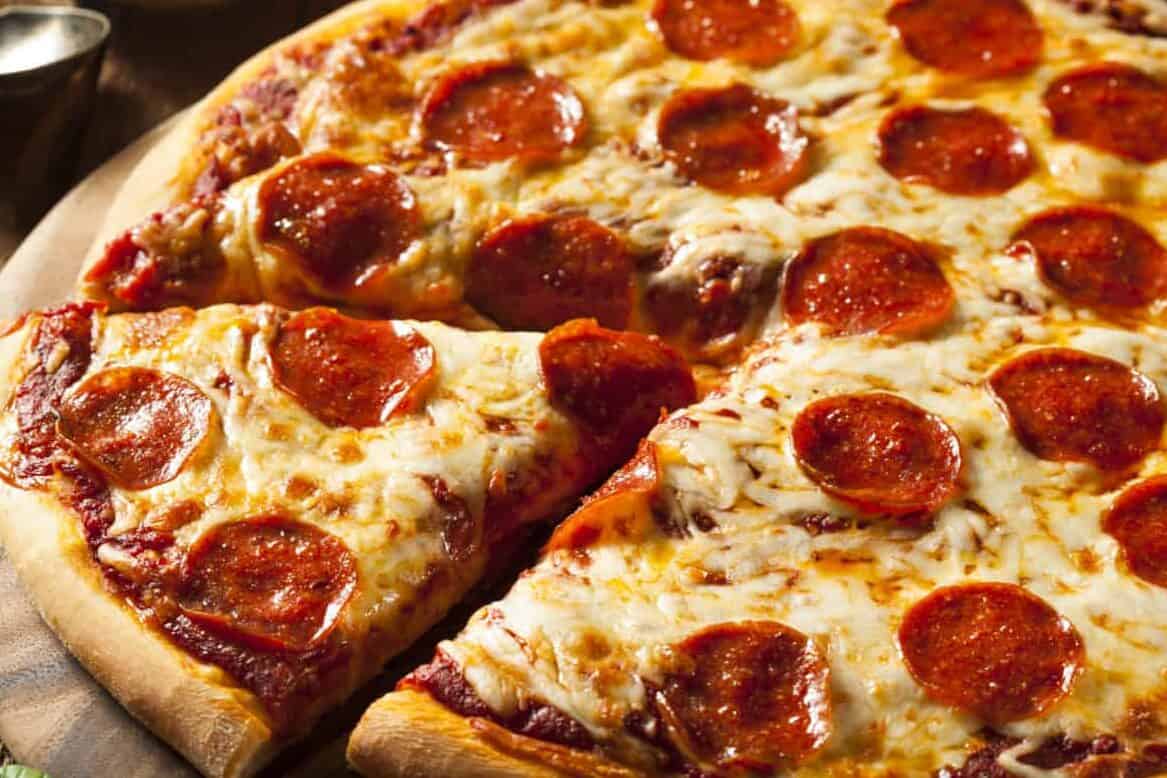
©Brent Hofacker/Shutterstock.com
Pizza can be considered unhealthy due to its high calorie, saturated fat, and sodium content. The combination of cheese, meat, and crust in pizza can contribute to its high-calorie count. Also, processed varieties of pizza, such as frozen and fast-food options, may contain unhealthy ingredients like preservatives, colorings, and unhealthy fats. However, it's important to note that the healthiness of pizza can vary depending on factors such as the type of crust, toppings, and portion size.
While there are potential negative aspects of pizza, it can be enjoyed as part of a balanced diet. For example, pizza can offer calcium from cheese and disease-fighting lycopene from tomatoes, and whole-wheat crust can provide whole grains and fiber.
Ultimately, it's important to consider your overall diet and make informed choices about the type of pizza you consume, portion sizes, and frequency of consumption. With this in mind, let’s explore 8 tips to enjoy pizza without gaining weight.
1. Watch Your Portion Size
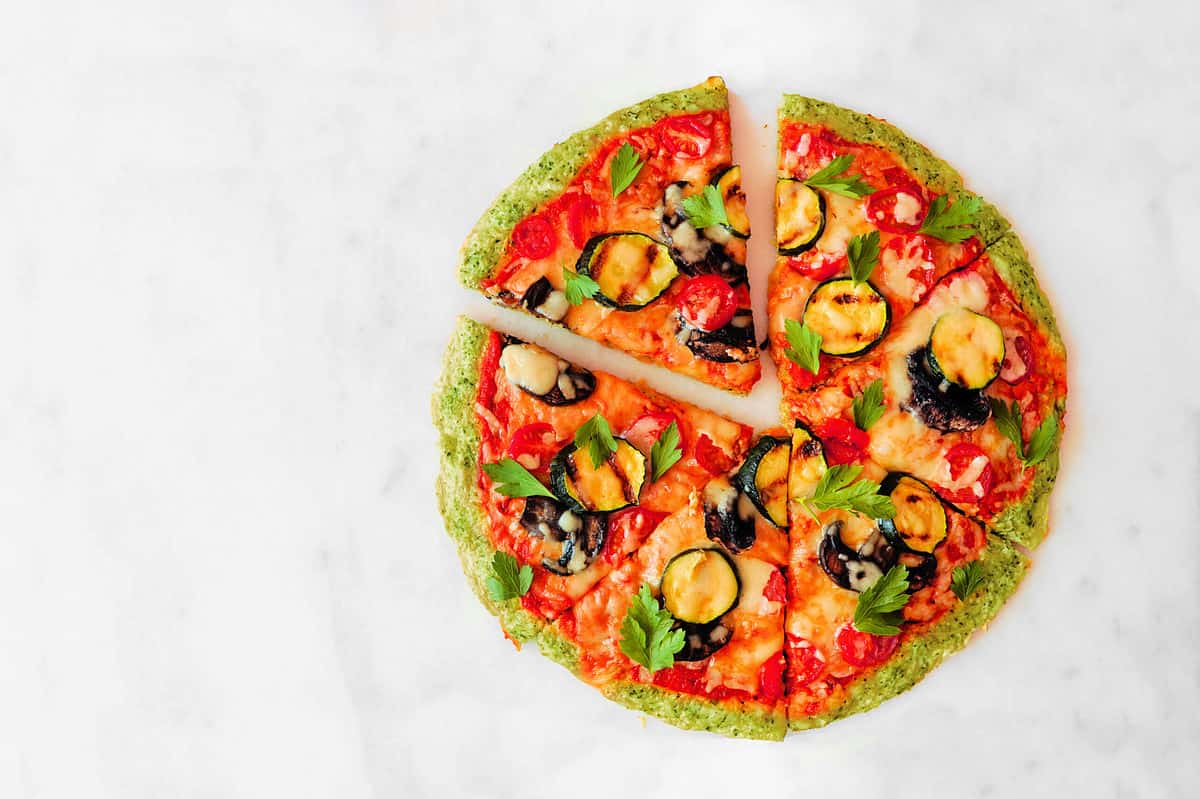
Even healthier pizzas should be portion-controlled.
©JeniFoto/Shutterstock.com
Pizza can be high in calories, and consuming large portions can lead to an excessive calorie intake. By practicing portion control, you can manage your calorie consumption and avoid consuming more calories than your body needs. Pizza is a delicious food that can be easy to overindulge in. By practicing portion control, you can still enjoy the flavors and experience of pizza without the negative consequences of overeating, such as feeling overly full or sluggish.
2. Go for Wheat or Whole Grain Thin Crust
When it comes to choosing a healthier pizza option, thin-crust pizzas are the obvious choice. Many of them are made with wheat or whole grain bases and are generally considered a better choice compared to thick crust or deep-dish pizzas. Also, whole-grain or wheat-based thin-crust pizzas can provide a higher fiber content compared to pizzas made with refined grains. Fiber is important for digestion, satiety, and overall gut health. Whole grains also have a lower glycemic index, releasing glucose into the bloodstream more slowly. This can help regulate blood sugar levels. You can even consider alternative crusts. For example, some recipes use ingredients like cauliflower and quinoa in their crusts which increases the nutritional value.
3. Choose Your Toppings Wisely
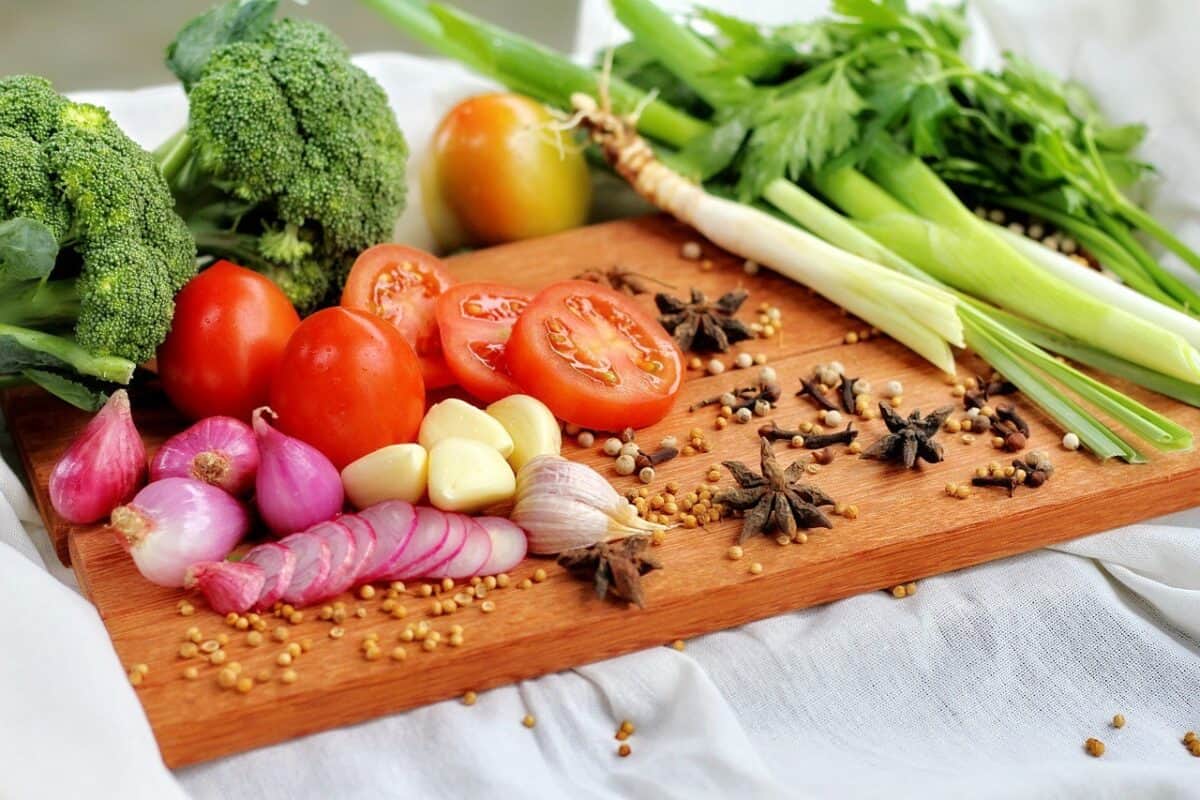
Putting lots of veggies on your pizza can add to its nutritional value.
©Anggun Aprilia Sovia/Shutterstock.com
Toppings like processed meats and fatty sauces can significantly increase the calorie content of a pizza. One way to continue enjoying pizza is to choose healthier pizza toppings. This includes:
Lots of Vegetables:
Loading up on vegetables can increase the pizzas' nutritional value and help you feel more satisfied without adding excessive calories. Here is a list of some healthy and delicious vegetable toppings for pizza:
- Tomatoes
- Mushrooms
- Onions
- Bell Peppers
- Spinach
- Zucchini
- Olives
- Broccoli
- Artichokes
- Fresh Basil
Lean Proteins:
You can also opt for lean proteins versus the standard pepperoni or sausage. When it comes to adding lean proteins to your pizza, here are some options to consider:
- Grilled chicken breast
- Lean ground turkey or sliced turkey breast
- Seafood such as shrimp, crab, or tuna
- Beans and Legumes such as black beans, chickpeas, or lentils
- Tofu (sauteed, grilled, or baked)
- Scrambled or sliced hard-boiled eggs
- Lean meats like lean beef, pork tenderloin, or lean ham can be used sparingly
4. Consider Alternative Sauces:
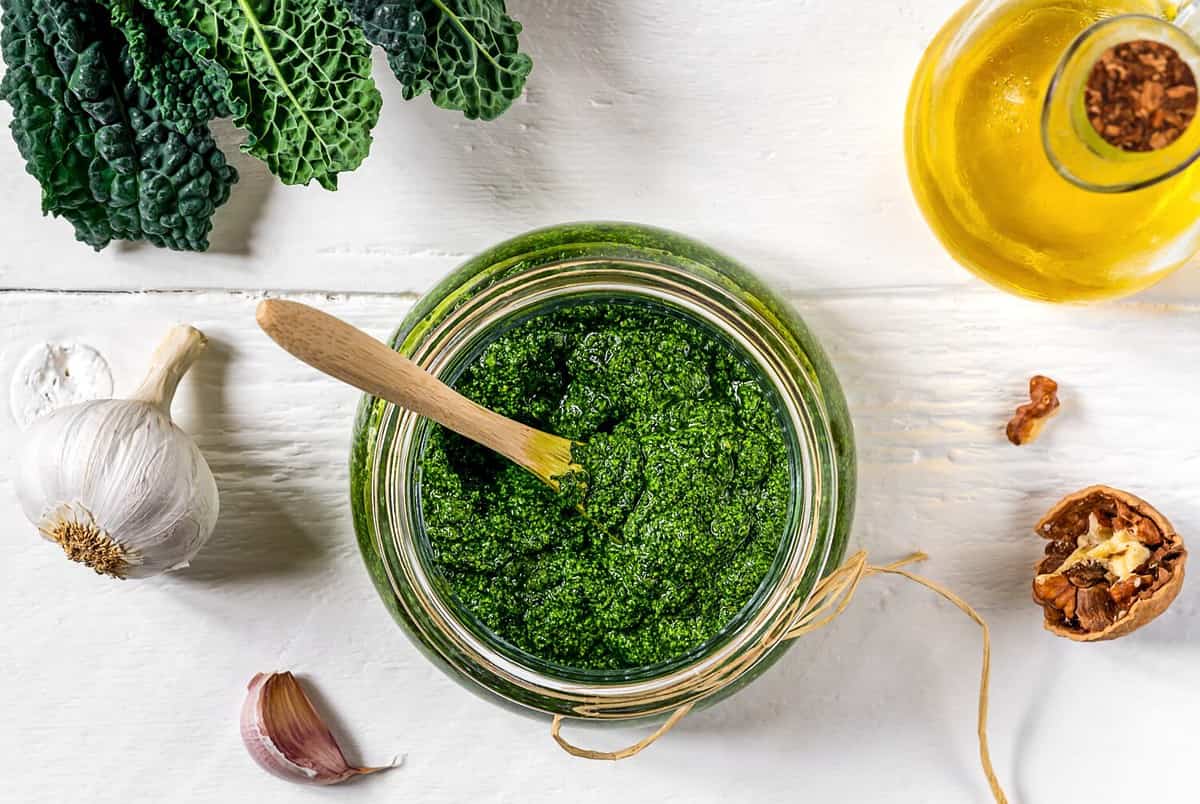
There are many other sauces you can put on a pizza besides tomato, including pesto sauce.
©Tati Liberta/Shutterstock.com
Pizza sauce itself is not inherently bad for you. In fact, it can provide some nutritional benefits. For example, tomato-based pizza sauce is typically made from tomatoes, garlic, herbs, and olive oil, which can offer vitamins, minerals, and antioxidants. However, there are a few reasons why pizza sauce might be considered less healthy, including high sodium and added sugars. When it comes to healthy sauces for pizza, there are several options to consider. Here are some ideas:
Low Sugar Tomato Sauce:
Look for pizza sauces that have no added sugar to keep the sugar content to a minimum. Making your own tomato sauce allows you to control the ingredients and avoid added sugars or preservatives. You can find easy recipes online that use simple ingredients like canned tomatoes, garlic, herbs (such as oregano and basil), and olive oil.
Pesto Sauce:
Pesto sauce, made from basil, pine nuts, garlic, Parmesan cheese, and olive oil, can add a flavorful and
aromatic twist to your pizza. It pairs well with a variety of toppings, especially vegetables and grilled chicken.
White Sauce:
Instead of tomato-based sauce, you can use a white sauce made from ingredients like béchamel sauce, Alfredo sauce, or a combination of ricotta cheese and olive oil. The white sauce adds a creamy and rich flavor to your pizza.
Barbecue Sauce:
Barbecue sauce can be a delicious alternative to traditional tomato sauce. It adds a tangy and slightly sweet flavor to your pizza. It pairs well with grilled chicken, red onions, and other barbecue-inspired toppings.
Salsa:
If you're looking for a spicy kick, salsa can be used as a sauce alternative. It adds a vibrant and zesty flavor to your pizza. Choose your preferred level of spiciness, whether it's mild or hot, and pair it with toppings like black beans, corn, and jalapeños.
Hummus:
Hummus can be a unique and healthy sauce alternative for pizza. It adds a creamy and tangy flavor and pairs well with Mediterranean-inspired toppings like olives, roasted red peppers, and feta cheese.
Olive Oil and Garlic:
For a simple and light option, you can brush your pizza dough with olive oil and sprinkle minced garlic on top. This creates a flavorful base for your toppings and allows their flavors to shine.
Avocado Base:
For a unique twist, you can try an avocado-based sauce. Mashed avocado mixed with spices like smoked paprika, black pepper, and salt can create a creamy and flavorful sauce that pairs well with pizza.
Roasted garlic:
Roasted garlic adds a rich and savory flavor to pizza sauce as well. You can roast garlic cloves in the oven until they become soft and caramelized, then blend them with tomato sauce or puree to create a delicious sauce.
5. Be Mindful of Cheese
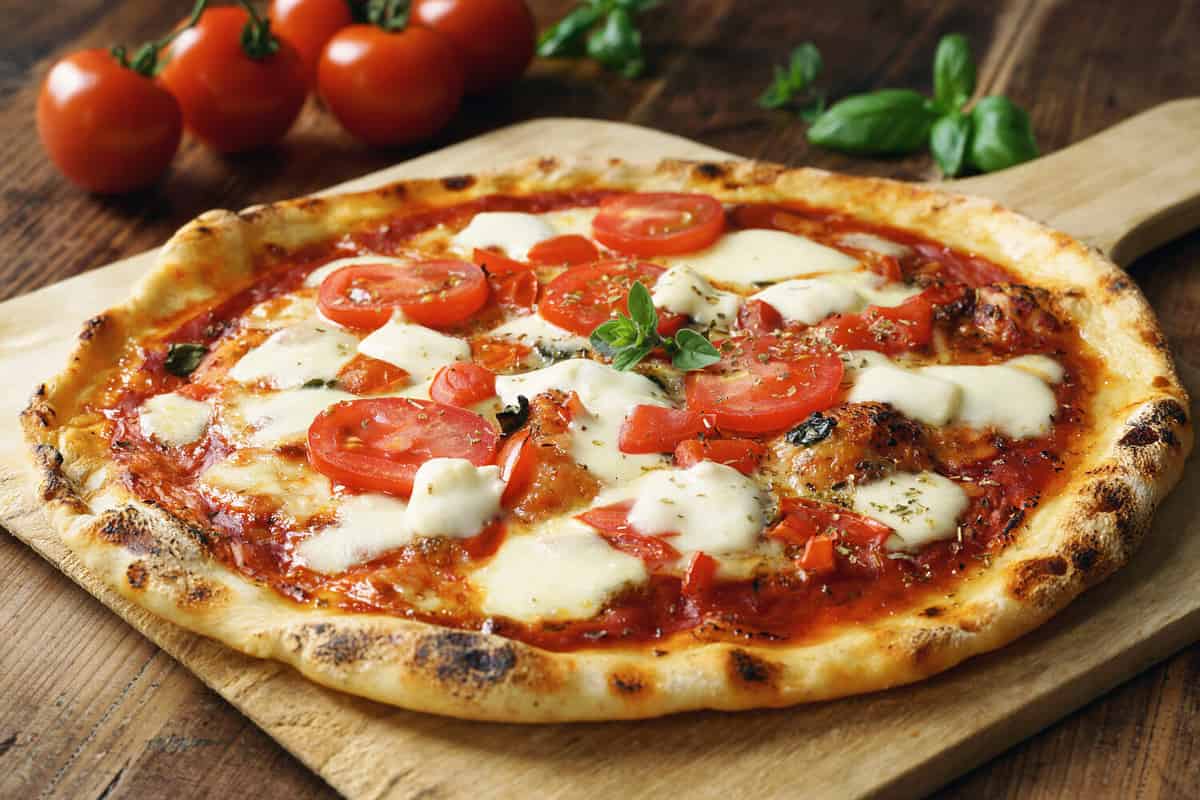
Fresh mozzarella or other cheeses such as feta can be healthier than shredded cheeses.
©V. Matthiesen/Shutterstock.com
Cheese is a delicious but calorie-dense ingredient in pizza. Be mindful of the amount of cheese you consume to keep your calorie intake in check. Say no to extra cheese and consider alternative cheeses that might be even healthier than the typical mozzarella cheese on pizza.
Mozzarella itself is already a relatively healthy choice compared to some other cheeses since it is lower in fat and calories compared to many other types of cheese. However, if you're looking for alternative cheese options that are considered healthier than mozzarella, here are a few to consider:
Feta cheese:
Feta cheese is a crumbly, tangy cheese that can add a unique flavor to your pizza. It is lower in fat and calories compared to some other cheeses, and it pairs well with Mediterranean-inspired toppings like olives, tomatoes, and fresh herbs.
Ricotta cheese:
Ricotta cheese is a creamy and mild cheese that can be used as a base or a topping for pizza. It is lower in fat and calories compared to many other cheeses and can add a rich and creamy texture to your pizza.
Goat cheese:
Goat cheese, also known as chèvre, has a distinct flavor that can add a tangy and creamy element to your pizza. It is lower in fat and calories compared to some other cheeses and pairs well with ingredients like caramelized onions, arugula, and roasted vegetables.
Fresh mozzarella:
While mozzarella is already a common choice for pizza, opting for fresh mozzarella can be a healthier alternative. Fresh mozzarella is typically lower in sodium and has a softer texture compared to regular mozzarella. It pairs well with fresh ingredients like tomatoes, basil, and balsamic glaze.
Vegan cheese alternatives:
For those following a vegan or dairy-free diet, there are now several vegan cheese alternatives available that can be used on pizza. These options are typically made from plant-based ingredients and can provide a lower fat and calorie content compared to traditional cheese. Some popular vegan cheese brands include Miyoko's, Violife, and Daiya.
6. Balance Your Pizza Meal
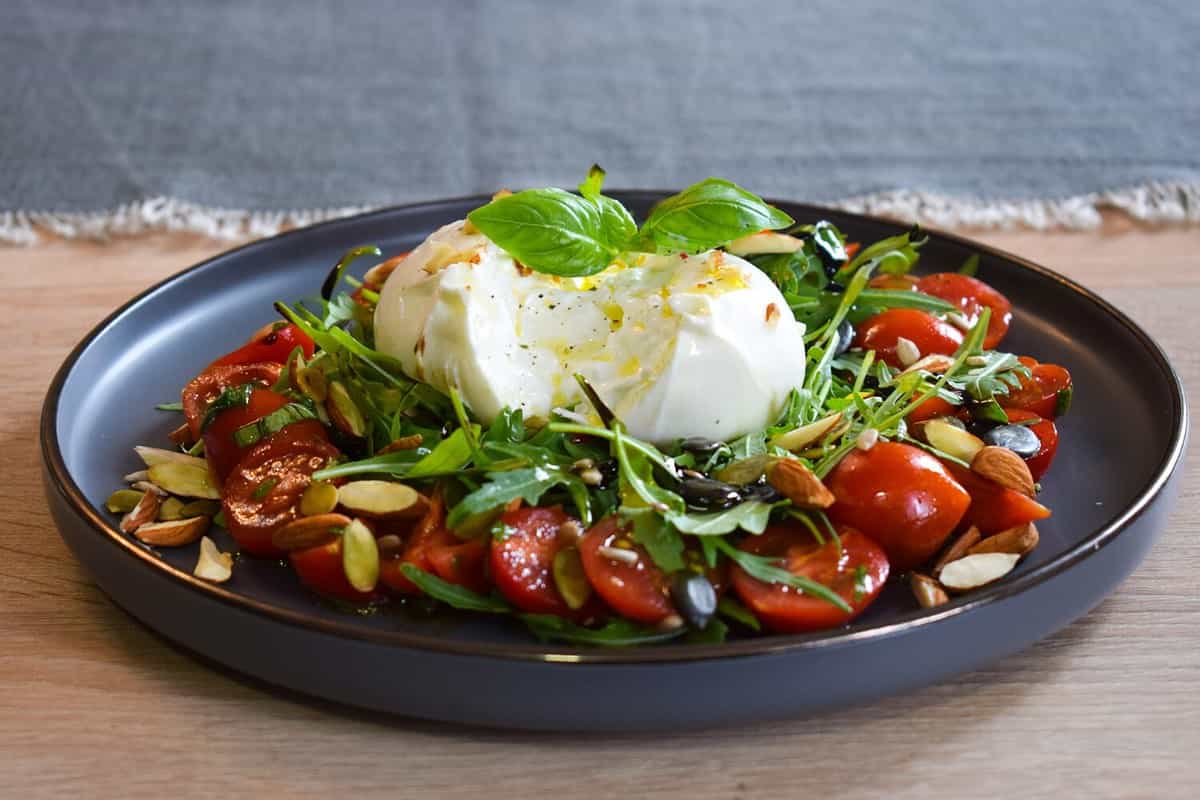
A small salad pairs perfectly with pizza and will help keep over-indulging tendencies at bay.
©Daniel Simoc-Minea/Shutterstock.com
Enjoying pizza as part of a balanced meal can help mitigate its impact on your weight. Instead of having multiple slices of pizza, enjoy a moderate portion and fill the rest of your plate with healthy sides. This way, you can still enjoy the flavors of pizza while incorporating nutritious options.
To balance a pizza meal and avoid overindulging, here are some healthy side ideas:
Side Salad:
Start your meal with a side salad filled with fresh vegetables. This will add fiber, vitamins, and minerals to your meal, helping you feel fuller and satisfied. Just be mindful of the dressing!
Steamed or Roasted Vegetables:
Instead of loading up on extra slices of pizza, choose a side of steamed or roasted vegetables. These nutrient-packed options will provide volume and flavor without adding excessive calories.
Protein-Rich Side:
Pair your pizza with a protein-rich side dish, such as grilled chicken skewers, baked tofu, or a small portion of lean meat. Protein helps promote satiety and can balance out the carbohydrate content of the pizza.
Go for Whole Grains:
Include a side of whole grains, such as quinoa, brown rice, or whole wheat bread, to add fiber and complex carbohydrates to your meal. These can help slow down digestion and keep you feeling full for longer.
Remember, it's important to listen to your body's hunger and fullness cues. Pay attention to portion sizes, eat slowly, and savor each bite. By incorporating these healthy sides and practicing mindful eating, you can enjoy your pizza meal without overindulging.
7. Practice Moderation
Moderation is a key principle when it comes to enjoying pizza without gaining weight. It's important to understand that indulging in pizza occasionally is perfectly fine but making it a regular habit can have negative effects on your health and weight management. Regularly consuming pizza in large quantities can contribute to weight gain, and increased risk of chronic diseases like obesity, heart disease, and type 2 diabetes.
Moderation helps minimize health risks and promotes overall health and well-being. Moderation helps you practice portion control, which is essential for weight management. By being mindful of the amount of pizza you consume, you can avoid overeating and keep your calorie intake in check.
Also, practice mindful eating during your pizza meal. Slow down, savor each bite, and pay attention to your body's hunger and fullness cues. This can help prevent overeating and promote a healthier relationship with food.
8. Be Mindful of Other Food Choices
When enjoying pizza in moderation, it's important to be mindful of your overall diet and make healthy choices in other meals and snacks throughout the day. For example, on days when you plan to have pizza, focus on consuming nutrient-dense meals for breakfast, lunch, and snacks. Include a variety of fruits, vegetables, whole grains, lean proteins, and healthy fats to ensure you're getting a good balance of essential nutrients.
Opt for lean protein sources such as grilled chicken, fish, tofu, or legumes in your meals leading up to pizza consumption. Protein helps promote satiety and can help balance out the overall nutritional profile of your meals. Also, be sure to drink plenty of water throughout the day to stay hydrated. Sometimes, thirst can be mistaken for hunger, so staying hydrated can help you differentiate between true hunger and thirst.
Remember, the key is to strike a balance between enjoying pizza as a treat and maintaining a healthy overall diet. By making mindful choices and incorporating nutritious foods into your meals and snacks, you can enjoy pizza without compromising your health and weight management goals.
Outside of the Box Healthy Pizza Ideas:
Pizza does not have to be put in a box all the time (pun intended)! Here are five outside-of-the-box healthy pizza ideas that include unique sauces, crusts, and toppings:
Cauliflower Crust Pizza with Pesto Sauce:
Use a cauliflower crust as a low-carb and gluten-free alternative. Top it with a homemade or store-bought pesto sauce, fresh tomatoes, mozzarella cheese, and your choice of vegetables like spinach or roasted red peppers.
Quinoa Crust Pizza with White Bean Sauce:
Make a quinoa crust by combining cooked quinoa, flaxseed meal, and seasonings. Top it with a creamy white bean sauce made from pureed white beans, garlic, lemon juice, and herbs. Add roasted vegetables like zucchini, bell peppers, and red onions for extra flavor and nutrition.
Pita Bread Pizza with Hummus Sauce:
Use whole wheat pita bread as a thin and crispy crust. Spread a layer of hummus as the sauce and top it with grilled chicken, cherry tomatoes, cucumbers, feta cheese, and fresh herbs like parsley or mint. This Mediterranean-inspired pizza is packed with flavor and protein.
Zucchini Crust Pizza with Roasted Garlic Sauce:
Create a zucchini crust by mixing grated zucchini, eggs, almond flour, and seasonings. For the sauce, make a roasted garlic sauce by blending roasted garlic cloves, Greek yogurt, lemon juice, and herbs. Top the crust with the sauce, grilled chicken or shrimp, cherry tomatoes, and feta cheese.
Sweet Potato Crust Pizza with White Sauce, Spinach, and Chicken:
Create a sweet potato crust by combining mashed sweet potatoes, almond flour, and eggs. Bake the crust until firm and golden. For the white sauce, mix Greek yogurt, lemon juice, garlic powder, and a touch of olive oil. Spread the sauce over the crust. Top with sautéed spinach, grilled chicken breast, and a sprinkle of feta or goat cheese. Bake until the cheese is melted and the toppings are heated through. This pizza offers a unique combination of flavors and textures while providing a healthy dose of vegetables and lean protein.
Remember, these are just a few ideas to get your creative juices flowing. Feel free to customize the sauces, crusts, and toppings based on your preferences and dietary needs. Get creative and have fun experimenting with different flavors and combinations to make your healthy pizza creations!
In Conclusion
In conclusion, while pizza can be considered a less healthy option due to its potential for high calories, sodium, and unhealthy toppings, it is possible to enjoy pizza without compromising your weight goals. By following these eight tips, you can make healthier choices when it comes to pizza. Opt for thin crusts, load up on veggies, choose lean protein and low-fat cheese, control portion sizes, and consider alternative sauces. Also, balancing your pizza with a side salad or healthier sides can further enhance the nutritional value of your meal and prevent you from over-indulging in too many slices. Remember, moderation and mindful choices are key to enjoying pizza while maintaining a healthy lifestyle. So go ahead, and savor a slice or two, guilt-free!
Please Note:
Remember, these tips are general guidelines and may not apply to everyone. It's always a good idea to consult with a healthcare professional or registered dietitian for personalized advice on maintaining a healthy diet.
The image featured at the top of this post is ©Wingedbull/Shutterstock.com
